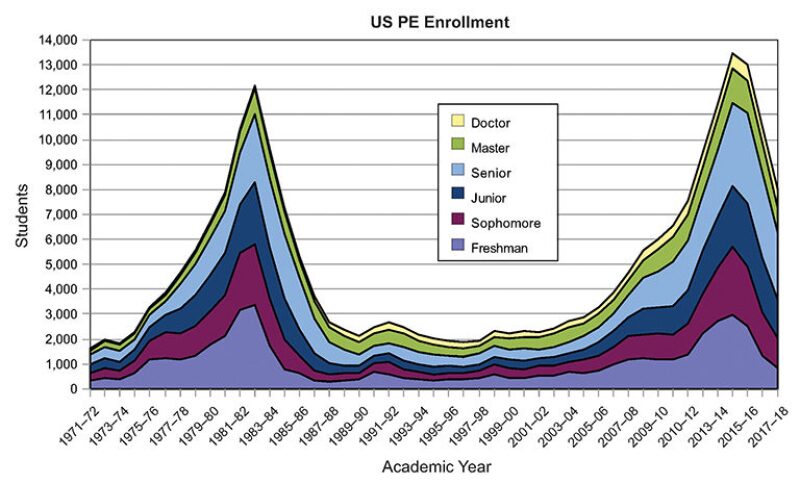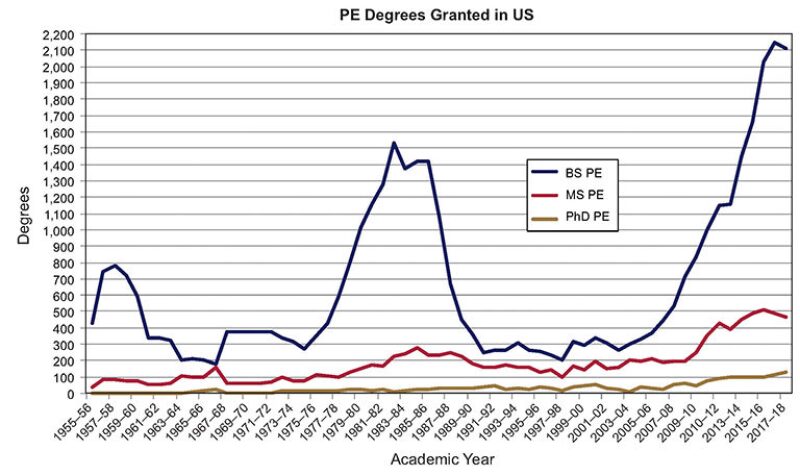The sharp oil price volatility during 2014–16 is now being felt by US undergraduate petroleum engineering (PE) programs, where enrollment is in steep decline after hitting record highs at the onset of the price downturn.
The number of US students pursuing bachelor’s degrees in PE programs fell to 6,263 in fall 2017 from 8,712 in fall 2016 as attitudes toward the discipline continued to shift, according to data compiled by Lloyd Heinze, PE professor at Texas Tech University’s Bob L. Herd Department of Petroleum Engineering. Enrollment in fall 2015 remained elevated at 11,069, slightly lower than a peak of 11,474 in fall 2014 when the oil price crash was under way—meaning it took 2 years before enrollment numbers began tracking oil prices.
“Students are starting to realize the job market is very different from when they started out as freshmen,” said Heinze, who has followed PE enrollment trends for decades. A student who is slated to graduate with a BS in PE this spring, for example, likely enrolled in fall 2014 after West Texas Intermediate (WTI) prices had spent much of the year at more than $100/bbl. In their sophomore year, WTI cratered to $26/bbl before stabilizing in the $40–60/bbl range for their junior and senior years.

With fewer students in the pipeline, fewer graduates are expected in the coming years, reversing an oversupply of those trying to enter the workforce. The number of undergraduate PE degrees granted is projected to plunge from more than 2,000 in each of 2015–16, 2016–17, and 2017–18 to around 1,220 in 2018–19 and 680 in 2019–20, Heinze’s data project. At 470 and 130, respectively, master’s degrees and PhDs granted are expected to remain somewhat elevated in 2017–18 compared with their averages during the previous decade. The steadier post-grad numbers may be supported in part by fewer available jobs.
One Extreme to Another
Heinze noted that Texas Tech’s PE department, like many PE departments across the country, is still reeling from the “tremendous overload” of students in recent years, a problem over which it had no control. “I can tell you that even if oil prices last year were $100/bbl, we were already on track to put out more students than $100/bbl can support.” Many public university PE programs are at the mercy of how many prospective students meet published admissions requirements. That is to say, programs cannot simply deny qualified students because those programs’ faculties, resources, and even lecture halls have become overextended. As a result, average undergraduate student-faculty ratios ballooned to about 46:1 in fall 2013.
On the US East Coast, Penn State University’s Petroleum and Natural Gas Engineering (PNGE) department’s undergraduate enrollment spiked from 184 students in fall 2010 to 860 students in fall 2014 before shrinking to 277 in fall 2017, according to Heinze data. Russell T. Johns, department chair, still laments the challenges his program faced due to over-enrollment. Resources for teaching assistants were short, and large classes had to be split into multiple sections. “Without GPA [grade-point-average] controls, we were predicting over 1,200 students in [fall] 2015, but you see that our numbers went down,” he said. “This was not because of oil price declines—yet.”
The department adopted administrative controls in fall 2012, a change that would take effect in summer 2013 and be reflected a couple of years down the road. Applicants are approved by administrators, typically the vice president for undergraduate affairs. When implemented, incoming freshman were required to earn at least a 3.0 GPA after taking between 40 and 59 credits, including scoring a C in five specific classes. The measure helped stem the tide of incoming graduates to an extent, but students continued to stream into the program at a higher-than-desired pace, prompting the department to raise the minimum GPA to 3.3. If oil prices had remained as high as they were before mid-2014, then the department would still have 800 students with a 3.3 GPA limit, Johns said. “It was that hot.”
He explained that the program is a popular option on the East Coast given the lack of PE departments there, so a large portion of its students come from outside of Pennsylvania. Demand for admission into the program was amplified by the shale revolution and the increasing quantity of high-paying jobs that made PE appealing. “Without the Marcellus, we would have grown, but maybe to just a few hundred students. I believe we were about 300 students in the early 1980s when oil prices were very high, but Pennsylvania no longer had much hydrocarbon production,” he said. “Pennsylvania is now second to Texas in gas production. It is a huge deal for us.”
Now PGNE enrollment “is falling so fast” that the department feels it cannot keep the minimum GPA at the current level of 3, he explained, but, “I want to have quality students, and we’re concerned about the uptick again.” With enrollment of 200 students currently being targeted, Johns said PGNE “will likely be going to academic controls in the future,” which means applicants would be approved by the faculty senate. A change would come with a minimum GPA of 2.5 for about 10 specific courses. “The advantage of these type of controls in a down year in the industry is that they allow us to control student influx if the oil business increases.”
At one point when enrollment was skyrocketing, PGNE had a student-faculty ratio of around 100:1. Now its faculty totals around 15, resulting in a more favorable ratio of about 20:1, “which is where it should be,” Johns said. Heinze emphasized that a PE program requires “at least three to five petroleum faculty to deliver it,” and some of the newer programs “started with a pretty bare amount of faculty.” Engineering faculty and engineering degrees themselves tend to be more expensive for a university compared with those of other programs, he said.
Heinze also mentioned challenges faced by both Texas Tech and other programs in fitting new courses into an already jam-packed curriculum. His program has removed core engineering courses to make way for upper-level petroleum-specific courses, which means its faculty is teaching more courses per student than in years past.

PE Shortage Looming?
Benefitting from the ability to cap its in-flow of students, the University of Texas’ Hildebrand Department of Petroleum and Geosystems Engineering’s enrollment peaked in fall 2011 with 597 undergraduates, but the department wanted to scale back to around 400, a total in line with its ideal student-faculty ratio of 20:1. During fall 2017, the program had 401 students enrolled. Jon Olson, department chair, said the program is now admitting 80–90 freshmen/year.
“The general interest of high school students in the petroleum business with the downturn has diminished, so we have seen our applications decline” from a few years ago when the program received about 17 applications for every spot it offered, said Olson. “Now we’re down more to the 5–10, 5–7 range, so we feel like we probably need to go out and do some recruiting now.” The department is coordinating recruitment efforts with local SPE chapters and alumni to promote the profession. It also has conducted energy camps during the summers with high school teachers to encourage discussion of issues such as environmental sustainability and its role in the industry.
At Texas A&M, where freshmen are not admitted into a specific engineering major but rather broadly into A&M’s college of engineering, interest in PE has dropped toward the bottom of engineering disciplines offered at the school. “Prior to the price drop, petroleum engineering was the No. 1 choice for freshmen who wanted to go to a particular department,” said John Lee, professor in A&M’s Harold Vance Department of Petroleum Engineering, where enrollment fell to 599 in fall 2017 from a peak of 812 in fall 2013. However, Lee noted the decline during that period was also heavily influenced by the removal of freshmen in department enrollment tallies and its own newly implemented enrollment cap.
Regarding future enrollment, Heinze said that it takes Texas Tech “4 or 5 years to significantly change the pipeline, and I don’t know if we’ll have enough students even if there is a boom.” He recounted the dramatic reduction in PE programs nationally during the late 1970s and early 1980s from around 35 to less than half that total after the 1980s oil bust. Programs in recent years “that got in the door when things were good are really going to struggle to maintain enough students,” Heinze said. “And whether or not their university allows them to continue becomes a big concern because [a university] can only have 18 or 20 programs [overall], and that doesn’t allow a lot of flexibility.”

Heinze’s data indicate that, by 2020, the trend of too many graduates is expected to flip to too few. “Even at $50–60 oil, [Texas Tech’s PE department] probably won’t have enough graduates coming out the door for the demand,” Heinze said. “You still have a lot of gray hair in the oil industry retiring, and that will continue happening.”
The swing reflects an overcorrection that often occurs when things are bad, Lee said. “Everyone thinks the sky is falling, the world is about to end, and they don’t want to get into something like petroleum engineering where there have been so many layoffs,” he said. It is why he is “personally—actively—encouraging every good student who has an interest to seriously consider getting into petroleum engineering.” He foresees in a few years “a shortage of qualified people graduating for the jobs that are going to be available.”
Olson agrees. “My impression is that in 2 or 3 years the demand for engineers is going to be really strong,” he predicted. “I just don’t see how [companies] are going to get their work done without staffing back up and getting more people in the business to do the work. I know that efficiencies have significantly increased as well. It takes a lot less rigs to drill the same number of wells today than it did just 5 or 10 years ago. But you still need a lot of scientists and engineers to put those programs together and manage those properties.”
Johns said he found it disconcerting that his program had to pump out so many students—more than it was able to handle—during a time when so few jobs were available.
“To me it’s really bad our whole field is so tied to oil price,” he said. Oil companies do PE programs a disservice “because when oil prices rise, they take anybody.” And then when prices are down, companies don’t even hire the best students. He believes the industry should take a more measured approach to hiring to balance the inflow of new employees between the good and bad times, as fluctuations in industry fortunes have always been—and will continue to be—the norm.

